In the last six months, Apple II users have enjoyed the fruits of Kickstarter, the crowdfunding site that’s been used to revive many classic game franchises. Soon, for the first time in decades, we’ll be able to enjoy new Space Quest and Leisure Suit Larry games.
But what if Kickstarter was used to reboot not just a particular franchise, but the entire gaming industry?
That’s what OUYA, a new video game console, looks to do.
http://www.kickstarter.com/projects/ouya/ouya-a-new-kind-of-video-game-console
The Android-based OUYA aims to move gamers away from mobile devices and place them in front of stationary consoles — but its OUYA’s development platform that is the focus of the Kickstarter pitch. The company’s founder, Julie Uhrman, harkens back to the days of the unwalled garden that early Apple products represented: "In the early days of gaming, you could take your Apple IIe, write your own programming, and take your game to market." Further endorsement from inXile’s Brian Fargo, creator of Wasteland, supports that throwback. Those were the golden days of gaming that launched epic series that continue to this day (again, courtesy Kickstarter). There was little competition in this new world, and artists and programmers were able to quickly stake their claim not only financially, but imaginatively, creating worlds for the sake of exploring this new digital realm. OUYA wants games to again be something that anyone can make and share.
But that was a different day and age. Although computers were accessible to program, the overall audience was small, making for a proportionally small number of programmers. Yes, there were games of questionable software — but there were so few games that the poor ones didn’t last long.
Bu contrast, today, anyone can be a programmer — and anyone often is. Although I’m all for the freedom and democratization if information, the fact that OUYA seems to be specifically not setting themselves up as curators of content on their console is concerning. If anyone can produce as much content, then anyone will, resulting in a glut of poor-quality software, or shovelware. I agree that Apple shouldn’t be their model — as gatekeepers of quality content, they do a pretty poor job (since "quality" to Apple doesn’t mean fun). But perhaps OUYA should look to the Nintendo Seal of Quality, which ostensibly meant that only that the publisher had paid a licensing fee, but realistically meant that gamers would experience a certain minimum amount of fun. The Seal was introduced to motivate publishers to put their best foot forward, limiting them to only three games per year. Programmers literally could not afford to produce bad games.
And from a technological perspective, it’s not challenging to stream video from an iOS or Android device to an HDTV. Is a separate console truly needed? Or is the attraction of OUYA not that it does something original, but that it does it simply, without the need for complicated or expensive peripherals?
Regardless of these questions and concerns, OUYA is already a success: at the time of this writing and with three more weeks to go, it has raised nearly $5 million USD, a funding level of 508% more than its required minimum. When over 32,000 backers get their consoles this September, we’ll find out if it has enough critical mass and sufficiently powerful mission statement to attract gamers — and developers.
UPDATE: For more on this subject, see my PCWorld blog post featuring video footage of KansasFest 2012, "John Romero Speculates On The Future of Ouya".





















